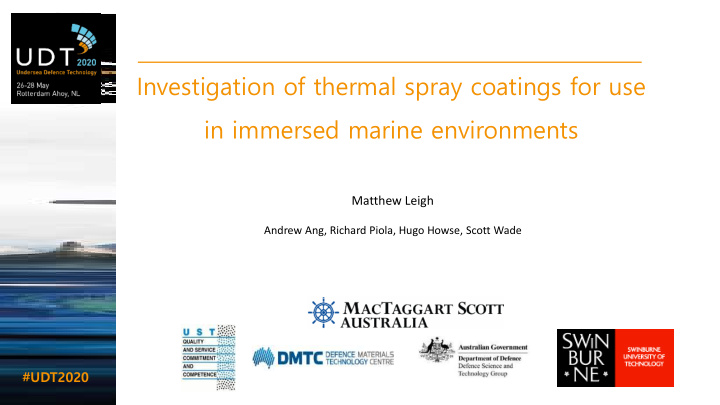



Investigation of thermal spray coatings for use in immersed marine environments Matthew Leigh Andrew Ang, Richard Piola, Hugo Howse, Scott Wade #UDT2020
Introduction Equipment installed in free food or sea spray conditions Exposed to harsh environments, can rapidly degrade equipment Potential water ingress, accelerates deterioration and reduces function DMTC led, cross organisational collaboration. #UDT2020
Project Partners • Swinburne University of Technology (SUT) Project Management, acceptance tests and spray parameters. Assisted with field testing and analysis. • United Surface Technologies (UST) Surface coating specialists, new coatings sprayed and optimised in house. • Defence Science and Technology Group (DST Group) Supplied specialists in corrosion and biofouling, analysed field work data and permitted access to field test sites. • DMTC Provided management and funding for projects. • MacTaggart Scott Australia (MTSA) Industry partner/end user of product, hydraulic design including seals, oils, surface finish and application. #UDT2020
Field Trial - One • Timeline: October 2015 to November 2016 • Over 100 samples, 5 coatings and 3 locations • Simulate in-service conditions • Custom enclosed area • Reduced light and flow conditions • Comparison of biofouling species, attachment strength, coverage and #UDT2020
Results – Field Trial One • Initial trials saw large amounts of biofouling on test samples • Large differences seen between coating types • Initial onset of biofouling increased on HVOF coated samples • Enables extended periods of dormancy when in-service • Reduced force to remove biofouling from HVOF surface Biofouling on APS coating, after 9 months. Biofouling on HVOF coating, after 9 months. #UDT2020
Field Trial - Two • Timeline: February 2018 to March 2019. • 6 samples, 3 coatings and 2 locations. • Simulate in-service operating conditions. • Operational prototype cylinder. • Comparison of biofouling species, coverage and settlement rates. • Recovery of biofouling after cycling regime. #UDT2020
Results – Biofouling Field Trial 2 • Growth rates and recovery of biofouling varied 2 months • No water ingress, seals remain in good condition growth • No corrosion present on cylinder or rod • Biofouling removed when cylinder retracts • Lower half untouched for 13 months, providing 13 months worse case scenario growth • Reduced onset of biofouling on HVOF samples • Inspection of rods once removed showed no damage to coating or material interface #UDT2020
In-Service Trial • Timeline: July 2018 to May 2019 • 10 cylinders with 5 different coatings 2 x High Velocity Oxygen Fuel (HVOF) 1 x Atmospheric Plasma Spray (APS) 1 x Electrolytic Hard Chrome (EHC) 1 x uncoated super duplex (SAF 2507) • Actual comparison of in-service conditions on a surface vessel • Different conditions from the previous two trials • Current EHC coating, not lasting the desired amount of time #UDT2020
Results – In Service Trial • Conditions saw EHC deteriorate rapidly • After 2 months EHC had noticeable defects • HVOF, APS and uncoated cylinders showed no signs of damage • HVOF had the least amount of debris on the rods surface • APS and uncoated have reduced impact strengths compared to HVOF • HVOF a stand out coating for this application Damage on EHC coating, after 11 months. #UDT2020 No damage present on HVOF after 11 months.
Future Work • Proposals for application onto new platforms both surface and sub surface • Refurbishing of existing equipment to enhance reliability and reduce maintenance costs • Increase operational reliability with greater protection from biofouling onset and mechanical damage #UDT2020
Conclusion • HVOF provides a superior coating technology for the areas of application tested throughout this project – Corrosion, biofouling and mechanical damage • Repair technique for existing equipment to provide cost saving on purchasing new items • Increased reliability of installed equipment, providing a cost saving to the customer • Increased confidence in equipment reliability • Faster turn around to repair damaged parts #UDT2020
Recommend
More recommend